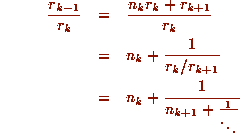Contents
Next: About this document
Continued Fractions and the GCD
Robert M. Corless
Thu Feb 29 16:42:01 PST 1996
Some time after I wrote ``Continued Fractions and Chaos'' I remembered that there was an extensive analysis of the connexion
between continued fractions and Euclid's algorithm for computing
GCD's in Knuth's The Art of Computer Programming, vol 2 (Seminumerical Programming). Section 4.5.3 in particular details
the connexion and uses it to analyse the complexity of the Euclidean
algorithm.
Knuth's description of the connexion is far superior to mine, and
I urge the reader to consult Knuth's book.
Here is a brief Maple version of the algorithm, which assumes with
no loss of generality that its input is two positive integers a
and b with a > b.
k := 1;
r[0] := a;
r[1] := b;
while r[k] > 0 do
n[k] := floor( r[k-1]/r[k] );
r[k+1] := rem(r[k-1], r[k]);
k := k + 1;
od;
Using the relation

 it's easy to see that the above do-loop simultaneously computes
the entries in the simple continued fraction for
it's easy to see that the above do-loop simultaneously computes
the entries in the simple continued fraction for  and performs
the Euclidean algorithm to compute the GCD of a and b (which
will be the last nonzero remainder
and performs
the Euclidean algorithm to compute the GCD of a and b (which
will be the last nonzero remainder  . See [] for
more details.
. See [] for
more details.
Additionally, it
turns out that my original statements in ``Continued Fractions and Chaos'' had it backward: it
is the properties of continued fractions that are used to prove that,
in the worst case, the Euclidean algorithm terminates after at most
ceil steps, where
steps, where  is the golden ratio, where
is the golden ratio, where  . In ``Continued Fractions and Chaos'', I claimed that the running time of the Euclidean algorithm gave us
this result for continued fractions (perhaps one could prove it this
way, as I thought that I had). This
is a result that Knuth attributes to Lamé from 1845, so my rather
blasé `it is easy to see' sounds rather weak.
. In ``Continued Fractions and Chaos'', I claimed that the running time of the Euclidean algorithm gave us
this result for continued fractions (perhaps one could prove it this
way, as I thought that I had). This
is a result that Knuth attributes to Lamé from 1845, so my rather
blasé `it is easy to see' sounds rather weak.
However, I think
at least the basic idea really is `easy to see'.
The basic idea I had in mind when writing ``Continued Fractions and Chaos'', which is the
same as that used by Knuth (I haven't seen Lamé's paper so I don't
know if Knuth made improvements) is that the slowest the algorithm
can go is if the quotients that occur are 1 every time:
 with q = 1. This gives us
Fibonacci numbers and the bound above. According to Knuth, and
I believe him, Lamé's result is the first `applied' use of Fibonacci numbers in the literature.
with q = 1. This gives us
Fibonacci numbers and the bound above. According to Knuth, and
I believe him, Lamé's result is the first `applied' use of Fibonacci numbers in the literature.
The average case complexity of Euclid's algorithm,
on the other hand, is formidably
difficult (I had not known that), and was not fully resolved until
Knuth himself put the final nail in, in 1976. Further, there are
intriguing connections with Gauss' work and ergodic theory---
which I mention later on in ``Continued Fractions and Chaos''---on p. 355 of Knuth's book we see the Gauss measure being used. More on this later, though. Now
back to the main paper.
Contents
Next: About this document
 steps, where
steps, where  is the golden ratio, where
is the golden ratio, where  . In ``Continued Fractions and Chaos'', I claimed that the running time of the Euclidean algorithm gave us
this result for continued fractions (perhaps one could prove it this
way, as I thought that I had). This
is a result that Knuth attributes to Lamé from 1845, so my rather
blasé `it is easy to see' sounds rather weak.
. In ``Continued Fractions and Chaos'', I claimed that the running time of the Euclidean algorithm gave us
this result for continued fractions (perhaps one could prove it this
way, as I thought that I had). This
is a result that Knuth attributes to Lamé from 1845, so my rather
blasé `it is easy to see' sounds rather weak.

 it's easy to see that the above do-loop simultaneously computes
the entries in the simple continued fraction for
it's easy to see that the above do-loop simultaneously computes
the entries in the simple continued fraction for  and performs
the Euclidean algorithm to compute the GCD of a and b (which
will be the last nonzero remainder
and performs
the Euclidean algorithm to compute the GCD of a and b (which
will be the last nonzero remainder  . See [] for
more details.
. See [] for
more details.
